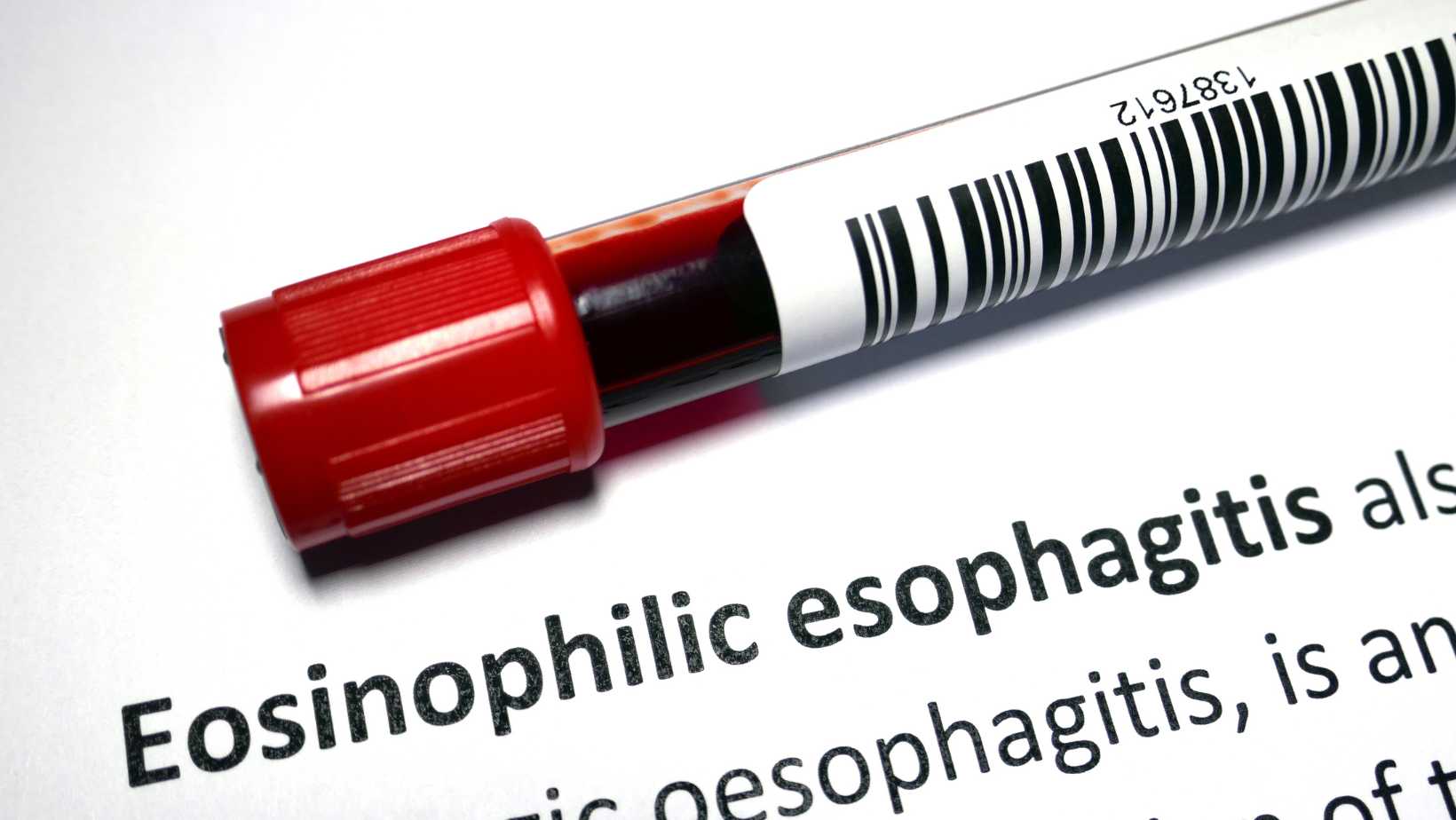|
Getting your Trinity Audio player ready...
|
Did you know that eosinophilic esophagitis disease is a rising health concern affecting millions of individuals worldwide? This chronic inflammatory condition, characterized by an overabundance of eosinophils in the esophagus, often goes undiagnosed or misdiagnosed, causing years of unnecessary suffering.
Table of Contents
ToggleBut what exactly is eosinophilic esophagitis disease, and why is it becoming increasingly prevalent? In this article, we will unravel the mysteries of this silent epidemic, exploring its causes, symptoms, and potential treatment options. If you or a loved one has been struggling with unexplained chest pain, difficulty swallowing, or other esophageal issues, read on to uncover the truth about eosinophilic esophagitis disease and discover how it can be effectively managed.
Before we dive deeper into the subject, it’s important to grasp the scale of this condition and the impact it has on individuals affected. Eosinophilic esophagitis disease has seen a staggering rise in recent years, with the prevalence increasing by 56%[1]. This spike in cases is alarming, underscoring the need for greater awareness and understanding of this often misunderstood ailment.
Throughout this article, we will explore the various facets of eosinophilic esophagitis disease: its etiology, the telltale symptoms to watch out for, the diagnostic process, and the available treatment options. By equipping yourself with knowledge and seeking appropriate medical care, you can take control of your health and find relief from the burdens caused by eosinophilic esophagitis disease.
Stay tuned as we embark on this enlightening journey, shedding light on eosinophilic esophagitis disease and empowering you to make informed decisions about your well-being.
Understanding Eosinophilic Esophagitis Disease
Are you curious about eosinophilic esophagitis, a chronic condition that affects the esophagus? In this section, we will provide you with a comprehensive understanding of this ailment, exploring its causes, symptoms, and treatment options.
Eosinophilic esophagitis is an inflammatory disorder that involves the accumulation of eosinophils, a type of white blood cell, in the lining of the esophagus. It is believed to be triggered by an immune response to certain food allergens or environmental factors.
Eosinophils, normally present in small numbers, can cause damage to the esophageal tissue when they are overabundant. This chronic condition can lead to a range of symptoms, including difficulty swallowing, chest pain, and food impaction.
To better understand eosinophilic esophagitis, let’s take a closer look at the role of eosinophils. These immune cells are typically found in the gastrointestinal tract and are responsible for modulating the body’s immune response to parasites and certain infections. However, in the case of eosinophilic esophagitis, their presence in the esophagus becomes problematic and contributes to inflammation and tissue damage.
It is important to note that eosinophilic esophagitis can affect individuals of all ages, from children to adults. If you or your loved ones are experiencing persistent symptoms, it is crucial to seek medical attention for proper diagnosis and management of this condition.
Eosinophilic Esophagitis: A Chronic Condition
Eosinophilic esophagitis is characterized as a chronic condition, meaning it is long-lasting and requires ongoing management. Without proper treatment, the inflammation in the esophagus can persist, leading to further complications and discomfort.
While eosinophilic esophagitis is not curable, several treatment options are available to help alleviate symptoms and reduce inflammation in the esophagus. These can include dietary modifications, elimination diets, medication, and in some cases, dilation of the esophagus to relieve strictures caused by the condition.
In the next section, we will delve into the specific symptoms associated with eosinophilic esophagitis, helping you recognize the signs and seek appropriate medical attention.
Recognizing the Symptoms
Recognizing the Symptoms of Eosinophilic Esophagitis is essential for early detection and appropriate management of this chronic condition. By understanding and being aware of the common signs, you can seek medical attention and start the necessary treatment promptly.
The symptoms of eosinophilic esophagitis can vary in intensity and frequency, but there are a few key indicators to watch out for:
- Difficulties swallowing (dysphagia): Many individuals with eosinophilic esophagitis experience difficulties when swallowing food or liquids. This can lead to discomfort, pain, and even choking episodes.
- Chest pain: Chest pain is another common symptom of eosinophilic esophagitis. It may be described as a burning or squeezing sensation in the chest, often mistaken for heartburn or acid reflux.
- Food impaction: Food impaction refers to the sensation of food getting stuck in the esophagus. It can cause extreme discomfort and may require medical intervention to remove the lodged food.
If you or a loved one experience any of these symptoms, it is important to consult a healthcare professional for a proper evaluation. While these symptoms can also be associated with other conditions, an accurate diagnosis is crucial for effective treatment.
To enhance your understanding of eosinophilic esophagitis symptoms, refer to the following table:
It is important to note that symptoms may vary from person to person, and individuals may experience additional symptoms not listed here. It’s crucial to consult a healthcare professional for an accurate diagnosis and personalized treatment plan.
Diagnosing Eosinophilic Esophagitis Disease
When it comes to diagnosing eosinophilic esophagitis, a comprehensive approach is essential. Your healthcare provider will consider your medical history, symptoms, and perform various tests to confirm the presence of the disease. These tests aim to identify the characteristic eosinophilic inflammation in the esophagus, ruling out other potential causes for your symptoms.
Endoscopy
Types Of Endoscopy is a common procedure used in the diagnosis of eosinophilic esophagitis. During this procedure, a thin, flexible tube with a camera attached (endoscope) is inserted through the mouth and into the esophagus. This allows your healthcare provider to visually examine the esophagus for any signs of inflammation or structural abnormalities. It also enables them to take small tissue samples, known as biopsies, for further examination.
Biopsy
Biopsy plays a crucial role in confirming the diagnosis of eosinophilic esophagitis. During endoscopy, several small tissue samples are taken from different areas of the esophagus. These samples are then examined under a microscope to assess the presence of eosinophils, a type of white blood cell that indicates inflammation. A high number of eosinophils in the esophageal tissue is a hallmark finding in eosinophilic esophagitis.
Other Tests
In addition to endoscopy and biopsy, your healthcare provider may order other tests to support the diagnosis of eosinophilic esophagitis. These tests may include:
- Blood tests: Blood samples may be analyzed to check for elevated levels of eosinophils and other markers of inflammation.
- Allergy testing: Allergy testing can help identify potential triggers that may be contributing to your symptoms.
- Esophageal pH monitoring: This test measures the acidity levels in your esophagus and can help rule out other conditions with similar symptoms.
The combination of these diagnostic methods provides a comprehensive evaluation of your condition, allowing for an accurate diagnosis and subsequent treatment plan. It is important to work closely with your healthcare provider and provide them with detailed information about your symptoms and medical history to aid in the diagnosis process.

Treatment Options for Eosinophilic Esophagitis
When it comes to Treatment Of Eosinophilic Esophagitis, there are various treatment options available. These options aim to reduce inflammation and relieve the symptoms associated with the condition.
Dietary Changes
Eosinophilic Esophagitis Diet play a crucial role in managing eosinophilic esophagitis. Elimination diets, such as the six-food elimination diet or the elemental diet, may be recommended. These diets involve removing specific food groups or consuming only amino acid-based formulas to identify and eliminate trigger foods.
Medication
In some cases, medication may be prescribed to help manage eosinophilic esophagitis. Corticosteroids, such as fluticasone propionate oral inhalers or budesonide oral suspension, are often used to reduce inflammation in the esophagus. Additionally, proton pump inhibitors may be prescribed to help control acid reflux.
Other Interventions
Aside from dietary changes and medication, other interventions may be considered for the management of eosinophilic esophagitis. These may include:
- Esophageal dilation: This procedure involves stretching the esophagus to alleviate swallowing difficulties caused by narrowing.
- Allergy immunotherapy: For patients with documented allergies contributing to eosinophilic esophagitis, allergy shots or sublingual immunotherapy may be recommended.
- Amino acid-based formulas: These specialized formulas can be used as a sole source of nutrition in individuals unable to tolerate specific foods.
Bear in mind that the most suitable treatment option for eosinophilic esophagitis varies from person to person. It is essential to consult with a healthcare professional to determine the most appropriate approach for your specific situation.
Conclusion
In conclusion, understanding and recognizing the symptoms of eosinophilic esophagitis is crucial for early diagnosis and proper management of the disease. This chronic inflammatory condition, characterized by the presence of eosinophils in the esophagus, can cause significant discomfort and impair swallowing function.
If you experience difficulties swallowing, chest pain, or food impaction, it is important to consult a healthcare professional. Through diagnostic procedures such as endoscopy and biopsy, the presence of eosinophilic esophagitis can be confirmed, allowing for targeted treatment.
Treatment options for eosinophilic esophagitis may include dietary changes, medications, or other interventions aimed at reducing inflammation and alleviating symptoms. Working closely with your healthcare provider is essential to develop a personalized treatment plan that meets your specific needs.
Remember, early intervention and ongoing medical support can significantly improve the quality of life for individuals with eosinophilic esophagitis. By staying informed and seeking proper medical attention, you can take control and effectively manage this condition.
FAQ
What is eosinophilic esophagitis disease?
Eosinophilic esophagitis disease is a chronic inflammatory condition that affects the esophagus. It is characterized by an increased number of eosinophils, a type of white blood cell, in the lining of the esophagus.
What are the causes of eosinophilic esophagitis disease?
The exact cause of eosinophilic esophagitis is unknown, but it is believed to be related to both genetic and environmental factors. Certain foods and allergens may trigger an immune response that results in the inflammation seen in eosinophilic esophagitis.
What are the common symptoms of eosinophilic esophagitis?
Common symptoms of eosinophilic esophagitis include difficulty swallowing (dysphagia), chest pain, food impaction (getting food stuck in the esophagus), heartburn, and acid reflux. In children, failure to thrive and poor appetite may also be present.
How is eosinophilic esophagitis diagnosed?
Diagnosis of eosinophilic esophagitis usually involves an endoscopy procedure, during which a flexible tube with a camera is inserted into the esophagus to examine the lining and take tissue samples (biopsies). These biopsies are then examined under a microscope to count the number of eosinophils present and confirm the diagnosis.
What are the treatment options for eosinophilic esophagitis?
Treatment options for eosinophilic esophagitis can vary depending on the severity of symptoms and individual factors. They may include dietary changes, such as eliminating specific foods that trigger symptoms, and/or medication to reduce inflammation. In some cases, endoscopic dilation or other interventions may be needed to relieve esophageal strictures or narrowings.
How important is seeking medical attention for eosinophilic esophagitis?
It is crucial to seek medical attention if you suspect you have eosinophilic esophagitis. Proper diagnosis and management are essential for relieving symptoms, preventing complications, and improving long-term outcomes. A healthcare provider can work with you to develop a personalized treatment plan and provide guidance on managing your condition.

Dr. Nivedita Pandey
Dr Nivedita Pandey is a Gastroenterologist in Delhi, Trained in the U.S and provides pre transplant evaluation as well as post-liver transplant care. She is compassionate and caring and is most well known for being a patient listener and spending ample time with patients.
Related Blog Posts
Symptoms Eosinophilic Esophagitis
June 21, 2024
Treatment of Eosinophilic Esophagitis
May 17, 2024





